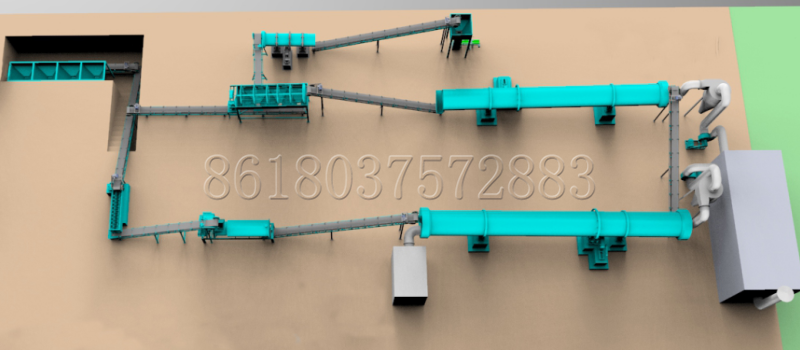The process flow of the compound fertilizer production line can usually be divided into: raw material ingredient, raw material mixing, raw material granulation, particle drying, particle cooling, particle classification, finished product coating, and then finished product packaging.
The compound fertilizer production line has low investment, quick results and good economic benefits. The complete set of equipment has a compact flow layout, scientific and reasonable, and advanced technology. Energy saving and consumption reduction, no three wastes are discharged, stable operation, reliable operation and convenient maintenance. The raw materials have wide adaptability and are suitable for the granulation of various raw materials such as compound fertilizers, medicines, chemicals, feeds, etc., and the product granulation rate is high. FPC production line for making compound fertilizer can produce compound fertilizers of various concentrations and types (including organic fertilizers, inorganic fertilizers, biological fertilizers, magnetic fertilizers, etc.), especially for granulation of dilute and ammonium bicarbonate series compound fertilizers. FPC company produces and sells products: non-drying compound fertilizer production line, non-drying compound fertilizer production machine, compound fertilizer equipment manufacturer.
Process

Raw material ingredients: urea, ammonium nitrate, ammonium chloride, ammonium sulfate, ammonium phosphate (monoammonium phosphate, diammonium phosphate, heavy calcium, ordinary calcium), potassium chloride (potassium sulfate) and other raw materials are equipped in a certain proportion (according to Market demand and local soil test results).
Stirring of raw materials: Stir the prepared raw materials evenly to increase the uniform fertilizer efficiency content of the overall fertilizer particles.
Raw material granulation: send the evenly stirred raw materials into the granulator for granulation (rotary granulators can be used, or extrusion granulators can also be used).
Granule drying: The granules made by the granulator are sent to the dryer, and the moisture contained in the granules is dried to increase the strength of the granules and facilitate storage.
Granule cooling: The temperature of dried fertilizer granules is too high and easy to agglomerate. After cooling, it is convenient for bagging and storage and transportation.
Particle classification: The cooled particles are classified, the unqualified particles are crushed and re-granulated, and the qualified products are screened out.
Finished film: Coating qualified products to increase the brightness and roundness of the particles.
Finished product packaging: Pack the film-coated particles, that is, the finished product, and store it in a ventilated place.

- The product pellets have equal and balanced nutrients
Because it is a chemical synthesis granulation, the nutrient content of the granular fertilizer is the same as the label, and it can provide the crops with nitrogen, phosphorus, potassium and other nutrients at a certain ratio at the same time to ensure the balanced growth of the crops.
- Good physical properties of the product
The particle size distribution of the product is uniform, 90% of which are particles with a particle size of 2-4 mm; the particles have high strength, good fluidity, and are not easily broken during transportation, storage and stacking. The design incorporates foreign advanced technology to further optimize the design performance of the device.
You can get the entire complete set of compound fertilizer production line in FPC. In addition, you can get the BB, NPK , urea based compound fertilizer production line at best cost. Please contact with us for detailed deisgn solutions. https://www.fertilizerplantcost.com/compound-fertilizer-production-line/

